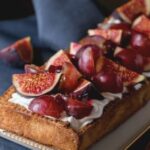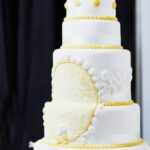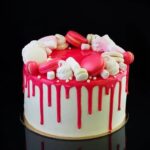Decorating a cake with flowers adds a touch of elegance and beauty that can elevate any special occasion. Whether you’re preparing a wedding cake, birthday cake, or simply want to create a stunning centerpiece for a gathering, incorporating flowers into your cake design can create a truly breathtaking result. Not only do flowers add color and vibrancy, but they also bring a natural aspect to the dessert, making it feel fresh and inviting.
The art of decorating cakes with flowers has been around for centuries, originating from the practice of using edible flowers and herbs to garnish culinary creations. Today, the technique has evolved to include both edible and non-edible flowers, offering endless possibilities in terms of aesthetics and creativity.
Not only are floral decorations visually appealing, but they also provide an opportunity to infuse flavors into your baked goods. Edible flowers can add delicate tastes and aromas that complement the flavor profile of your cake. From traditional roses, lavender buds, and chamomile blossoms to exotic options like pansies or borage flowers – there is an abundance of choices when it comes to selecting the perfect botanical elements for your creation.
In this article, we will explore various tips and techniques to help you master the art of decorating cakes with flowers. We will guide you through selecting the right type of flower materials, preparing them properly for use on cakes, arranging them in eye-catching ways, and offer tips on how to preserve their freshness.
Whether you’re a beginner or an experienced baker looking for new inspiration, this comprehensive guide will equip you with all the information needed to create stunning floral designs on your cakes. Let’s dive into the world of flower embellishments and bring your creations to life.
Choosing the Right Flowers
Choosing the right flowers for decorating a cake is essential to ensure both aesthetic appeal and safety. Not all flowers are suitable for cake decoration, as some may contain toxins or pesticides that could pose a health risk if ingested. When selecting flowers for cake decoration, it is important to consider factors such as color, size, and compatibility with the cake’s flavor profile.
Firstly, it is crucial to choose flowers that are labeled safe for consumption. Many florists offer edible flowers that have been grown specifically for culinary use. These flowers are typically free from harmful chemicals and safe to eat. Some common edible flowers include roses, pansies, violets, marigolds, and lavender.
Next, consider the color and size of the flowers in relation to your cake design. Brightly colored flowers can add a pop of vibrancy to your cake, while more delicate pastel tones create an elegant and subtle touch. The size of the flower should also be proportionate to the size of the cake; smaller cakes may benefit from smaller blooms or petals scattered across its surface.
To ensure food safety and avoid any potential allergic reactions or adverse effects, it is recommended to purchase organic and pesticide-free flowers. This guarantees that no harmful chemicals have been used during cultivation or preservation processes.
Lastly, consider the flavor profile of both the cake and the chosen flowers. Some edible flowers possess flavors that can complement certain cakes or fillings excellently. For example, lavender pairs well with vanilla-based cakes while rose petals go harmoniously with lemon-flavored confections.
By taking these tips into consideration when choosing flowers for cake decoration, you can create a visually stunning masterpiece without compromising on taste or safety.
| Flowers | Suitability for Cake Decoration |
|---|---|
| Roses | Safe and versatile; available in various colors |
| Pansies | Edible and vibrant; perfect for adding pops of color |
| Violets | Dainty and edible flowers that add elegance to a cake |
| Marigolds | Edible and available in bold, warm hues |
| Lavender | Aromatic and pairs well with vanilla-based cakes |
Preparing the Flowers
Before placing flowers on a cake, it is crucial to prepare them properly to ensure that they are safe for consumption and maintain their freshness. Here are some steps you should follow when preparing flowers for cake decoration:
- Choose fresh, high-quality flowers: Select flowers that are in full bloom and have vibrant colors. Avoid wilted or damaged blooms as they may not hold up well on the cake.
- Remove any unwanted parts: Carefully remove any leaves, stems, thorns, or other non-edible parts from the flowers. These parts can release unwanted flavors or textures into the cake.
- Wash the flowers: Gently rinse the flowers under running water to remove any dirt, insects, or pesticide residue. Be cautious not to damage delicate petals while washing.
- Let them air dry: After washing, place the flowers on a clean paper towel or cloth and allow them to air dry completely. Make sure they are completely dry before using them on the cake to prevent moisture from damaging the icing.
- Refrigerate if needed: If you need to store the prepared flowers for later use, place them in an airtight container and refrigerate them until you’re ready to decorate the cake.
Remember to always handle edible flowers with care as they are delicate and can be easily damaged during preparation. If you’re unsure about how certain flowers will react with food, it’s best to consult a florist or do some research before using them in your cake decoration.
By taking these precautions and investing time in preparing your flowers properly, you can ensure that your cake not only looks stunning but also remains safe for consumption.
Edible vs Non-Edible Flowers
When it comes to decorating a cake with flowers, one of the main decisions you’ll need to make is whether to use edible or non-edible flowers. Each option has its pros and cons, and understanding them will help you make an informed decision for your cake decoration.
Edible Flowers
Using edible flowers on a cake not only adds beauty but also allows your guests to enjoy the floral flavors in each bite. Edible flowers are typically grown specifically for culinary use, ensuring they are safe and free from harmful pesticides. Some popular edible flowers for cake decoration include roses, pansies, lavender, violets, and marigolds.
Pros of using edible flowers:
- Added flavor: Edible flowers can infuse your cake with unique and delicate flavors.
- Safe to consume: Since these flowers are intended for consumption, they undergo rigorous testing to ensure they are safe to eat.
- Natural colors: Edible flowers come in vibrant hues that can enhance the overall visual appeal of your cake.
Cons of using edible flowers:
- Limited availability: Finding a wide variety of edible flowers may be challenging depending on your location and the season.
- Short shelf life: Edible flowers have a shorter shelf life compared to non-edible ones. They may wilt quickly once placed on the cake.
- Potential allergies: Even though these flowers are safe for most people, there is always a risk of allergies. It’s important to inform guests about any potential allergens in the cake decorations.
Non-Edible Flowers
Non-edible flowers offer a diverse range of shapes and colors for cake decoration. These flowers are mainly used for decorative purposes rather than consumption due to potential toxicity or because they haven’t undergone the necessary testing for culinary purposes. It’s important to note that their contact with the cake should be limited, and they should not be consumed.
Pros of using non-edible flowers:
- Endless variety: Non-edible flowers provide a vast array of colors, shapes, and sizes to choose from, allowing for unique and eye-catching cake designs.
- Durability: Unlike edible flowers, non-edible ones tend to withstand longer periods without wilting or losing their shape.
- Availability: Non-edible flowers are typically more widely available throughout the year, making it easier to find specific varieties and colors.
Cons of using non-edible flowers:
- Potential toxicity: Some non-edible flowers may contain toxins that can be harmful if ingested. It’s crucial to research each flower’s safety before using them as cake decorations.
- Limited use: Since these flowers cannot be consumed, they are mainly used for aesthetic purposes only, limiting their functionality on the cake.
- Preparation required: Non-edible flowers need thorough cleaning and preparation before use. They must be free from dirt, pests, and any harmful substances that could contaminate the cake.
Whether you choose edible or non-edible flowers for your cake decoration ultimately depends on your preferences, needs, and the purpose of the cake. If you want to add a hint of flavor while enjoying beautiful aesthetics, edible flowers might be your best choice.
On the other hand, if you prioritize an extensive range of colors and long-lasting decoration options without consumption concerns, non-edible flowers will cater to your needs. Whichever option you select, remember to exercise caution and proper preparation techniques when incorporating flowers into your cake design.
Organic and Pesticide-free Flowers
When it comes to decorating cakes with flowers, using organic and pesticide-free flowers is not only important for the overall aesthetic but also for the health and safety of those who will be consuming the cake. This section will delve into the significance of choosing organic and pesticide-free flowers for cake decoration and provide tips on where to find them.
Why Organic and Pesticide-Free Flowers?
Using organic and pesticide-free flowers ensures that there are no harmful chemicals present on the blooms that could potentially contaminate the cake. Pesticides can leave residues on flowers, which may be ingested by individuals when consuming decorated cakes. By opting for organic and pesticide-free flowers, you can have peace of mind knowing that your cake is safe and free from any harmful substances.
Finding Organic and Pesticide-Free Flowers
When selecting flowers for cake decoration, it’s essential to source them from trustworthy suppliers who prioritize organic practices. Many florists now offer organic options or specifically state that their flowers are pesticide-free. Farmers markets are also a great place to find locally-grown, organic blooms.
Additionally, consider growing your own flowers if you have a garden or access to outdoor space. This way, you have complete control over how they are cultivated and can ensure they are free from pesticides.
It’s important to communicate with your florist or flower supplier about your specific requirements in terms of using organic and pesticide-free flowers for cake decorating. They should be able to guide you in selecting the right types of blooms that meet your needs while maintaining their freshness and beauty.Price-points may vary depending on availability, seasonality, and location but remember that opting for organic is an investment in your health and well-being.
Flower Arrangement Techniques
Arranging flowers on a cake can significantly enhance its visual appeal and create a stunning centerpiece for any occasion. With the right techniques, you can achieve breathtaking results that will impress your guests. Here is a step-by-step guide on how to arrange flowers on a cake:
- Selecting the Right Flowers: Start by choosing flowers that complement the overall theme and color scheme of your cake. Consider the size, shape, and colors of the flowers, as well as their fragrance, if desired. It is important to pick flowers that are safe for food consumption and non-toxic. Some popular choices include roses, pansies, violets, daisies, and chamomile.
- Preparing the Flowers: Before placing the flowers on your cake, it is essential to properly clean and prepare them. Gently remove any dirt or debris from the petals and stems by rinsing them in cool water. Trim any excess leaves or thorns from the stems using clean scissors or floral shears. Allow the flowers to dry completely before arranging them.
- Creating a Base: Start by creating a base for your flower arrangement on the cake. You can use buttercream frosting or fondant to make small mounds at various points on the cake’s surface where you want to position the flowers. This will provide stability and prevent direct contact between the flowers and icing.
- Arranging the Flowers: Begin arranging the flowers by inserting their stems into the prepared mounds or directly into an edible flower holder (such as floral picks or drinking straws) if needed for support. Place larger blooms in focal points and fill in gaps with smaller ones for balance and visual interest. Experiment with different arrangements until you achieve your desired look.
To ensure food safety, it is crucial to inform your guests about which flowers are edible and which are for decoration only. Additionally, remember that some flowers can release moisture onto the cake, which may affect its texture or cause colors to bleed. Therefore, it is best to arrange the flowers shortly before serving the cake and refrigerate it until then.
By following these flower arrangement techniques, you can transform an ordinary cake into a work of art. The key is to select flowers that complement the overall design of the cake, prepare them properly, and arrange them strategically for maximum impact. With practice and creativity, you can achieve breathtaking results that will leave your guests in awe.
Alternative Flower Decorations
When it comes to decorating a cake with flowers, there is no limit to creativity and the possibilities are endless. While traditional arrangements can be stunning, there are also plenty of alternative flower decorations that can add a unique touch to your cake. Here are some ideas to inspire you:
- Petal Cascade: Instead of arranging whole flowers on the cake, consider using just the petals for a delicate and whimsical look. You can create a cascading effect by gently scattering petals from the top of the cake down to the sides. Choose petals in complementary colors to create an ombré effect or stick to one color for an elegant monochromatic design.
- Flower Crown: Add a bohemian touch to your cake by creating a flower crown around the base or top tier. Use small flowers like baby’s breath, chamomile, or daisies, and arrange them in a circular pattern. This decoration works particularly well for rustic or outdoor-themed cakes.
- Floral Wreath: A floral wreath is a beautiful way to decorate the edges of your cake. Choose smaller flowers like lavender, rosemary, or marigold and secure them together in a circular shape using floral wire or toothpicks covered in green tape. Place the wreath around the perimeter of each tier for an enchanting and romantic look.
- Pressed Flowers: For a vintage and artistic look, consider using pressed flowers on your cake. Press edible flowers like pansies or violets between sheets of parchment paper for a few weeks until they are completely dry and flattened. Carefully place them onto the cake, securing them with a light layer of frosting or edible adhesive.
- Flower Confetti: Instead of using whole flowers, create confetti-like flower decorations by cutting petals into small pieces and scattering them across the cake. This is a great option for adding pops of color or creating patterns on the cake’s surface. You can even mix different types and colors of flower petals for a vibrant and festive look.
- Flower Appliques: Add elegance to your cake with flower-shaped appliques made from gum paste or fondant. Roll out the gum paste or fondant to your desired thickness and use flower-shaped cutters to create delicate shapes. Allow them to dry before attaching them to the cake using edible glue or royal icing.
| Idea | Description |
|---|---|
| Petal Cascade | Create a cascading effect by scattering petals from top to sides. |
| Flower Crown | Add bohemian touch with small flowers arranged in a circular pattern. |
| Floral Wreath | Decorate the edges of the cake with a circular wreath of smaller flowers. |
These alternative flower decorations allow you to personalize your cake and create a design that truly reflects your style and occasion. Remember to always take into consideration the color palette, theme, and overall aesthetic of your cake when choosing alternative flower decorations.
Tips for Applying Flowers
Choosing the right flowers
When it comes to applying flowers on a cake, it is crucial to select the appropriate blooms that will not only enhance the cake’s overall aesthetic but are also safe for consumption. Not all flowers are edible or suitable for contact with food, so it is essential to be mindful of any potential toxicity. Opt for flowers that are organically grown and free from pesticides.
Preparing the flowers
Before using any flowers on a cake, proper preparation is necessary to ensure their cleanliness and safety. Start by gently washing the flowers under cool water to remove any dirt, debris, or insects. Be careful while handling delicate petals to avoid any damage. Afterward, gently pat dry each flower using a soft cloth or paper towel to remove excess moisture.
Securing the Flowers
To securely place flowers on a cake without damaging the icing or causing them to wilt, there are several methods you can employ:
- Flower picks: Use small plastic stems called flower picks to insert into the base of each flower before placing them on the cake. This will help prevent direct contact between the flower and icing while providing stability.
- Toothpicks: For smaller flowers or delicate petals, gently insert a toothpick through the base of each flower and then press it into the cake at an angle. Ensure that only the toothpick touches the cake, not the stem or petals.
- Floral wire: For larger or heavier flowers like roses, consider using floral wire as additional support. Wrap a small piece of floral wire around the base of each flower’s stem and insert it into the cake at an angle.
Remember always to use caution when working with fresh flowers on cakes, as some people may have allergies or sensitivities. Additionally, it’s essential to communicate clearly with those consuming the cake about which decorations are edible and which should be removed before eating the cake. By taking these precautions, you can confidently apply flowers to your cakes with ease and create stunning, professional-looking designs.
Preserving the Flowers
Preserving the freshness and beauty of flowers on a cake is essential to ensure that they look vibrant and appealing throughout the duration of an event. There are several techniques you can use to prolong the life of the flowers and keep them looking their best.
Choosing fresh and sturdy flowers
When selecting flowers for cake decoration, it’s important to choose ones that are fresh and in peak condition. Look for flowers with strong stems and petals that are not wilted or bruised. Avoid using flowers that have started to discolor or shed their petals, as these will not last long on a cake.
Hydration techniques
One of the key factors in preserving the freshness of flowers on a cake is ensuring they stay hydrated. To do this, you can use floral water tubes or floral picks filled with water to hold individual flower stems. These tubes can be inserted into the base of each stem, providing a water source for the flower while it is on the cake.
This technique helps prevent wilting and keeps the flowers looking fresh. Be sure to regularly check and refill the water tubes throughout the event if necessary.
Refrigeration
Another way to preserve the freshness of flowers on a cake is by placing it in a refrigerator between servings or when it’s not being displayed. The cool temperature helps slow down wilting and keeps the blooms looking vibrant. However, before refrigerating, it’s essential to cover the cake loosely with plastic wrap or a cake dome to protect it from absorbing any unwanted flavors or smells from other items in the fridge.
By following these preservation techniques, you can maximize the longevity of your flower decorations on cakes. Remember to also consider factors such as humidity and direct sunlight when displaying your cake, as these can accelerate wilting. With proper care, your flower decorations will continue to enhance the visual appeal of your cake throughout your event.
Final Touches
In the final stages of decorating a cake with flowers, adding additional embellishments or accents can truly enhance the overall aesthetic and make the cake stand out even more. These finishing touches allow you to customize the design and create a unique masterpiece that reflects your personal style or fits a specific theme or occasion.
One popular option for adding final touches is using edible glitter or sparkle. Edible glitter comes in various colors and adds a touch of shimmer and glamour to your cake. Simply sprinkle it over the flowers or any other desired areas of the cake to create a dazzling effect. Additionally, you can use edible pearls, dragees, or small fondant decorations to add texture and dimension.
Another way to enhance the overall aesthetic is by incorporating ribbons or bows into the design. Choose ribbons that complement the color scheme of your cake and tie them around the base of each tier or between flower arrangements. This adds an elegant and sophisticated touch to any cake.
For more creative options, consider using edible paper designs or images. These come in various patterns, such as lace, floral prints, or even personalized images. Simply cut out the desired shapes and apply them to the cake’s surface using edible glue or water.
| Embellishment/Accent | Description |
|---|---|
| Edible Glitter | A shimmering powder available in various colors; adds sparkle to the cake |
| Ribbons/Bows | Decorative ribbons tied around tiers or between flower arrangements; adds elegance |
| Edible Pearls/Dragees | Small edible decorations that add texture and dimension to the cake |
| Edible Paper Designs/Images | Paper designs or images that can be cut out and applied to the cake’s surface for a customized look |
Adding these final touches allows you to take your cake decorating skills to the next level. Remember to keep the overall theme and design in mind when selecting embellishments or accents, ensuring they complement the flowers and create a harmonious visual appeal. With careful attention to detail, your cake will become a true work of art that will not only look stunning but also delight everyone who sees it.
Conclusion
In conclusion, decorating a cake with flowers is a beautiful and elegant choice that can elevate any occasion. Throughout this article, we have discussed various aspects of cake decoration with flowers, from choosing the right flowers to arranging them on the cake and preserving their freshness.
Firstly, it is essential to choose the right flowers that are safe for cake decoration. By ensuring that the flowers are non-toxic and pesticide-free, we prioritize the health and safety of those enjoying the cake. Properly preparing the flowers, such as cleaning them thoroughly, is also crucial to maintain their freshness and cleanliness.
Additionally, we have explored the options of using edible or non-edible flowers for cake decoration. While edible flowers provide an added burst of flavor and can be consumed along with the cake, non-edible flowers offer more variety and visual appeal. The choice ultimately depends on personal preference and dietary restrictions.
Furthermore, we have discussed various flower arrangement techniques and alternative ideas for decorating cakes with flowers. From traditional arrangements to unique designs, there is truly no limit to creativity when it comes to floral cake decorations. Tips for securely placing the flowers without damaging the icing or causing wilting have also been provided.
Finally, adding additional embellishments or accents can enhance the overall aesthetic of the cake even further. This could include ribbon bows, sugar pearls, or even additional decorative items like fondant figurines.

Welcome to my blog about home and family. This blog is a place where I will share my thoughts, ideas, and experiences related to these important topics. I am a stay-at-home mom with two young children. I hope you enjoy reading it! and may find some helpful tips and ideas that will make your home and family life even better!





